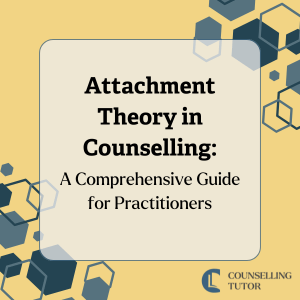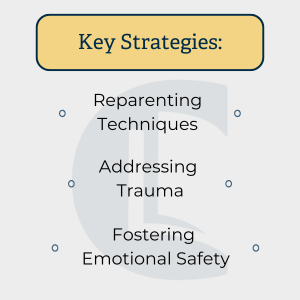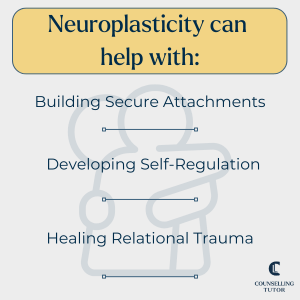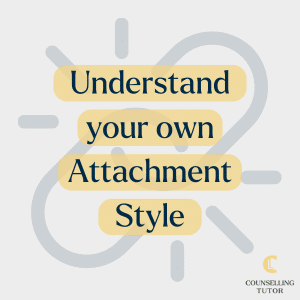Free Handout Download
Attachment Theory in Counselling: A Comprehensive Guide for Practitioners
Attachment theory, a cornerstone of modern psychotherapy, offers an understanding of human behaviour rooted in early relational experiences. Developed by pioneers like John Bowlby and Mary Ainsworth, the theory provides a lens through which therapists can view client attachment patterns and their implications for emotional and relational functioning. This article explores attachment theory’s foundational concepts and practical applications in counselling and psychotherapy.

Attachment Theory in Counselling: A Comprehensive Guide for Practitioners
Attachment theory, a cornerstone of modern psychotherapy, offers an understanding of human behaviour rooted in early relational experiences. Developed by pioneers like John Bowlby and Mary Ainsworth, the theory provides a lens through which therapists can view client attachment patterns and their implications for emotional and relational functioning. This article explores attachment theory’s foundational concepts and practical applications in counselling and psychotherapy.
By the end of this exploration, you should be able to:
Ken Kelly: Attachment theories is a fascinating theory of how infants, little children, bond with their parents. And that bond lays the path for how they bond and interact with people in their future.
Rory Lees-Oakes: If they have a good form of attachment to a caregiver then it’s very likely that as they turn into adults, they will have good relationships or be able to sustain relationships with others.
I’m reminded of a quote by Søren Kierkegaard, life has to be led forward, but viewed backwards. What he meant by that was our life today is foundationed by our past experience and certainly our relationships with others. And that is why attachment theory, and understanding attachment theory is so important.
Ken Kelly: Thank you, Rory. Attachment theory lies in our development as human beings.
You mentioned secure attachment, that is a person that is maybe quite balanced.
Within secure attachment, the person might be okay with themselves, or comments and feedback from others wouldn’t trigger them. How does that attachment form in those early years?
Well there’s a number of theories that have been put forward. But before I go there, I just want to say a good way of thinking about attachment, certainly if you’re an adult is, I’m okay, you’re okay. Borrowing that from transactional analysis, it literally is that, you’re right in yourself, you feel secure in yourself.
Rory Lees-Oakes: And when you’re with others, you feel secure with them. I’m okay. You’re okay. And what can happen is that people who have faulty attachments, either don’t feel okay in relationships, or they feel not okay with others, I think that would be a very simplified way of using TA theory.
To explain what attachment is in adult life, it started with John Bowlby. Bowlby was a psychiatrist who had a poor upbringing. He was sent to a boarding school in the 1940s, as a consequence it set him on a path of trying to understand what happens when children are separated from their mother.
Bowlby’s view of attachment was biological, and in fact, he argued that attachment theory was intrinsic in increasing chances of survival. Bowlby, after the Second World War, did a piece of research on refugees for the World Health Organisation at the time, he came to the conclusion that children who didn’t have an attachment could find themselves in some difficulty.
So that’s the basis of it, Ken.
Ken Kelly: Thank you, and I like how you referred to, I’m okay, you’re okay.
And then of course we have, I’m okay, you’re not okay. These are the TA terms that are used, meaning I can’t trust anybody. If you want a job doing, you’ve got to do it yourself, I’m really suspicious about people. Because I’m okay, you’re not okay.
And then, of course, the other side of that is, you’re okay, I’m not okay. I don’t feel okay with myself, I don’t feel confident in the choices, the decisions I make, what I say. I look to others for validation. So if I have an opinion or a thought on something and you say, no, that’s wrong, it’s actually like this.
Am I understanding that correctly, Rory?
Rory Lees-Oakes: Yeah, pretty much. There was a theorist called Mary Ainsworth who is often cited as giving us three views of attachment. Ainsworth was herself a very accomplished child psychologist.
And she did a number of experiments called strange situation. Basically, a mother would accompany a child into a room with toys, and then the mother would leave, child would be on their own, and a stranger would go into the room. The researchers would observe how the child reacted to the stranger, and when the mother came back observe the behaviour of the child towards the mother. And she split attachments into three ideas, secure attachment, which would be the I’m okay,
you’re okay. And the child feels confident that the caregivers, the mother was okay, not too distressed, maybe a little bit puzzled about the whole thing. And then you have avoidance attachment I’m okay, you’re not okay, if we use those TA terms. And they would avoid perhaps the mother and would show very little distress during the separation.
You know, would be distant from the mother. And then you have something called ambivalence, a resistance attachment, which is you’re okay, I’m not okay. And the child would be maybe clingy, difficult, feel very distressed during the separation.
And that became the predominant idea, certainly in social work, through the 70s and into the 80s about attachment.
Ken Kelly: Thank you, and I guess what I’m looking for now is how does this apply to therapy? One of the exercises that we did when we were teaching together, Rory, is we would encourage our students to identify and understand their own attachment style.
But how does it translate into therapy when a client has a certain attachment style? What might we see?
What are the clues we’re looking out for, Rory?
Rory Lees-Oakes: That’s a very good question, Ken. First of all is the therapist and the client relationship, and what’s from the past may be played out in the relationship.
If I’m working with clients and they may get very distressed at the idea of leaving, or at the idea that therapy may come to an end, that could be ambivalent attachment played out.The person may be reluctant to leave what they perceive as a caregiver. It may be that you have on the opposite side, someone who’s avoidant. Maybe they’re not connecting, and through the arc of the relationship you have with the client they may very well not make a connection with you. There can be lots of reasons for that.
And secondly, relationships with others. A lot of therapy, in my experience, focuses on the experiences that the client has with other people and in relationships especially.
Sometimes you may get nuggets of information that the client reveals in therapy. It might be a client saying I’m having relationship troubles with men, it might be that the father wasn’t very present.
I really have difficulty with intimacy with women and that could be a sign of difficulty in the past, they may say my mother was very cold to me, she didn’t have much time for me.
Now I feel that in relationships, I just don’t feel the person is connecting enough to me. That speaks to attachment.
So there’s quite a few things there to consider, Ken.
Ken Kelly: With secure attachment, the client is able to describe their experience and their feeling fully and in a balanced way, so they have access to their feelings, they’re not holding anything back. Avoidant attachment, in which the client is unable to elaborate on anything, providing only minimal answers.
They’re holding something back or they don’t feel that they’re able to share that. Sticking to the facts rather than their feelings. I think this all boils down to trust. I’m holding a little bit back because I don’t fully trust. And then with the anxious attachment, the client talks quickly, and it’s really difficult for you, the therapist, to follow and to make space for any intervention.
I can certainly relate to seeing all of those types of presentations, and it doesn’t mean they necessarily fall under this theory. But understanding the theories at least gives us more of an understanding of where that client might be coming from.
So if we suspect that a client might be acting from a certain attachment style, is there anything we can or should be doing as a counsellor or is it just a matter of noting that?
Rory Lees-Oakes: It depends on the situation, Ken. Personally, I wouldn’t jump in immediately.
I would look for a pattern of behaviour in a client. If that came up, I might reflect that back. I might say, it’s a bit of a struggle for you to connect with people emotionally, and you mentioned a difficulty with your mother or father in the past.
Could there be a connection there? Try and help them join the dots.
And I’d like to also say something about cultural competence here, because attachment theory is a very westernised, Eurocentric idea. And in African cultures, there’s a idea of alloparenting, and that involves child care responsibilities amongst multiple caregivers.
So we have to be thoughtful that from some cultures, collective cultures, attachment theory may not be a really good fit. And I think, all therapists need to be culturally competent and not overlay Western Eurocentric ideas on clients who are not from that sphere of the world.
Ken Kelly: Thank you Rory and one more area that I’d love to touch on. I’m not okay, but you’re not okay. Now, that is a person who doesn’t trust themselves, doesn’t trust those around them. What might we see in that kind of individual? How might they present or show themselves in the world?
Because that’s a horrible place to be, living in a world where you don’t trust yourself and your own abilities, and you don’t trust anyone else that gives you advice or guidance. It sounds very lost.
Rory Lees-Oakes: It’s a terrible thing. Someone who’s terrified at the same time as being very lost and alone.
And what you’re alluding to is the work of Main and Solomon in the eighties, the last big piece of attachment ideas. And that is disorganised attachment where a child may be in a situation with a parent where they’re either having to be the parent, even as a little child, because the parent isn’t capable, or they’re in a very abusive situation.
Horrified and terrified is the way it was described to me when I did my attachment training. This idea of not being able to trust self, mainly driven from the fact that they didn’t have any agency when they were children, to be able to make any changes because they’re only little, and then horrified about what was happening around them.
With people who have a disorganised attachment style, it can take a long time for them to integrate themselves. The part of them that trusts themselves isn’t there, the part of them that puts their trust in other people is lost. For someone who explores that, it’s about consistency of the therapist, being consistent in the relationship.
There’s a term coined called a good enough mother, and it’s been changed to the good enough other, I think this is where psychotherapy excels because what you’re doing is reparenting. You can do it as a counsellor, but it’s not going to be five sessions. This is a long term engagement where the therapist becomes a secure object. That work is done thoughtfully, and boundaried. And the client realises this is going to be a long time piece of work.
From what I’ve read and discussed with colleagues, there isn’t an absolute cure for this. It’s something that may be managed, not cured.
Ken Kelly: Thank you. And that bit that you’ve just said there, there’s no cure for this. As counsellors, psychotherapists, we can understand our own attachment style, we can work around our own attachment style, we can maybe change the behaviours that come up when we see that attachment style, but you mentioning there’s no fix. It doesn’t go away.
And in times of extreme stress, when we lose the ability to think clearly, there is a reverting back to that original attachment style. I certainly see that within my own life. I have an attached anxious attachment style. So it’s I’m okay, you’re not okay is my attachment style. And I have to check that all the time. I see it come up often within my life. When I see it, I am able to modify my behaviours around it. But when I’m stressed, when I’m under pressure, I revert back to that attachment style.
And that can be pretty tricky, can’t it?
Rory Lees-Oakes: It can be, my own attachment style’s avoidant dismissive and you make a very good point about reverting back.
Therapy will help you build new ways of thinking about yourself. Good therapy will allow somebody to be aware of why they’re feeling how they are.
And generally speaking, it’s all good. But in extreme stressful situations, the new neural pathway you build through therapy to manage your attachment may not be available to you.
So you go down the old neural pathway. In summary, as a therapist, the best you could hope for, is that they have an awareness.
There’s no cure, but people can manage it. People can understand the process and manage it.
Ken Kelly: Thank you, Rory, and thank you for bringing this topic.
This topic is so important and shows itself so often, and I encourage you identify your own attachment style. There’s a lot of fun in that
A British psychiatrist, John Bowlby, is credited with developing attachment theory in the mid-20th century. His work stemmed from post-World War II observations of orphaned children, which led him to conclude that early attachment to a caregiver is critical for normal social and emotional development.
Key contributions of Bowlby include:

Mary Ainsworth, a student of Bowlby, introduced the “Strange Situation” experiment, categorising attachment into secure, avoidant, ambivalent, and disorganised styles. Her work demonstrated the behavioural impacts of caregiver interactions.
Additionally, Harry Harlow’s studies with monkeys underscored the importance of “contact comfort,” further validating the theory’s principles.
Understanding the four main attachment styles – secure, avoidant, ambivalent, and disorganised – is essential for tailoring therapeutic interventions. Each style reflects unique patterns of emotional regulation, relational behaviours, and coping mechanisms shaped by early experiences with caregivers.

Traits:
Therapeutic Approach:
Traits:
Therapeutic Approach:
Practical Example: An avoidant client might delay or deflect answering emotional questions. Practitioners can respond patiently, highlighting the client’s autonomy while gently guiding them toward self-reflection.
Traits:
Therapeutic Approach:
Practical Example: Ambivalent clients may strongly desire connection during one session and withdraw in the next. Therapists can acknowledge this pattern with curiosity and acceptance, reinforcing the safety of the relationship.
Traits:
Therapeutic Approach:
Practical Example: A disorganised client may unexpectedly terminate therapy after a deep session or form an intense but fleeting attachment to the therapist. Address these behaviours without judgment, using them as opportunities to explore the client’s fears and relational history.

By recognising and adapting to these styles, therapists can create a therapeutic environment that allows for trust, self-awareness, and growth. Each style offers unique challenges and opportunities, requiring a tailored approach honouring the client’s history and current needs. Remaining consistent and empathetic in the therapeutic process provides the foundation for meaningful, lasting change.
Attachment Theory in Counselling: A Comprehensive Guide for Practitioners
One of the most promising insights from attachment research is the brain’s capacity for change through neuroplasticity – the ability of neural pathways to adapt and reorganise in response to new experiences. This principle underpins the therapeutic potential to help clients rewire maladaptive attachment patterns, offering hope for healing and transformation regardless of early experiences.
Counsellors and psychotherapists play a crucial role in activating this potential by providing a consistent, empathetic, and nurturing relationship. This therapeutic alliance is a corrective emotional experience, helping clients build new relational templates.

Key strategies include:
Through these strategies, therapists can leverage neuroplasticity to support clients in:

The brain’s ability to adapt underscores the transformative power of therapy. By intentionally encouraging these changes, practitioners repair past wounds and empower clients to approach future relationships confidently and securely.
Attachment theory provides therapists with a rich framework for understanding and addressing relational and emotional challenges. Its principles can be seamlessly integrated into therapeutic practice to encourage deeper client insight, strengthen the therapeutic alliance, and support healing across diverse client populations.
Key considerations for practice include:
The brain’s ability to adapt underscores the transformative power of therapy. By intentionally encouraging these changes, practitioners repair past wounds and empower clients to approach future relationships confidently and securely.
To fully leverage the benefits of attachment theory:
Attachment Theory in Counselling: A Comprehensive Guide for Practitioners
By integrating attachment theory into practice, therapists can offer clients a deeper understanding of their relational challenges and the tools to overcome them. This approach improves therapeutic outcomes and empowers clients to form healthier, more fulfilling connections.
Attachment theory equips counsellors and psychotherapists with a robust framework for understanding and supporting clients. By recognising the enduring influence of early attachments, therapists can tailor interventions that promote healing and growth.
This article reflects the richness of attachment theory and its practical relevance for psychotherapy, guiding practitioners to integrate its principles effectively into their work.
As a practitioner, continuously deepening your understanding of attachment theory will enrich your practice and enhance your ability to facilitate transformative change.

Bowlby, J. (1951) Maternal Care and Mental Health. Geneva: World Health Organization.
Gerhardt, S. (2004) Why Love Matters: How Affection Shapes a Baby’s Brain. London: Routledge.
Moran, H. (2010) ‘The Coventry Grid: A Framework for Differentiating Attachment-Related and Neurodevelopmental Disorders’, Journal of Child Psychology and Psychiatry, 51(4), pp. 1-10.
Van der Kolk, B. (2014) The Body Keeps the Score: Brain, Mind, and Body in the Healing of Trauma. New York: Viking.
Learn the theory basics.
Notice any broken link or issues with this resource? Kindly let us know by email
Email us